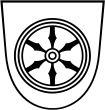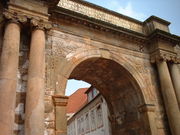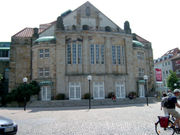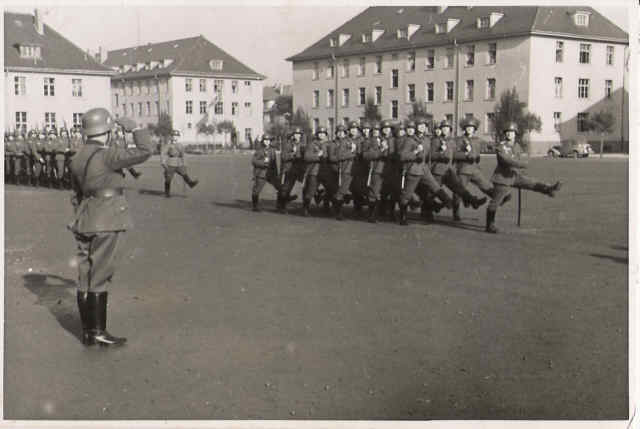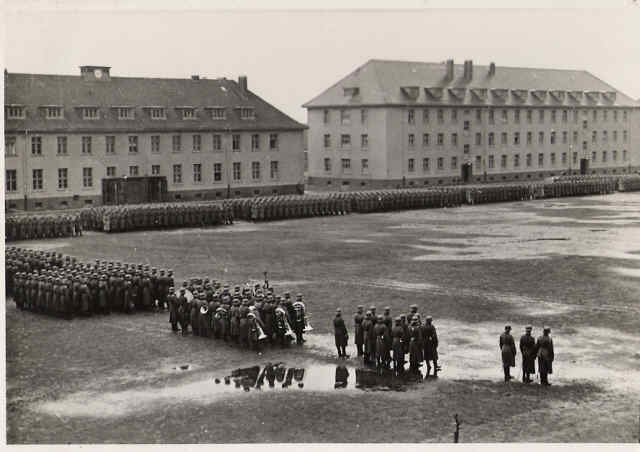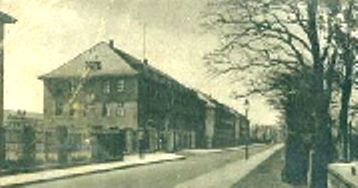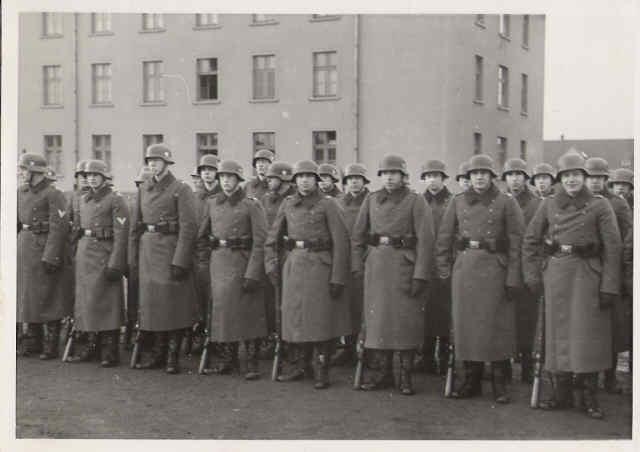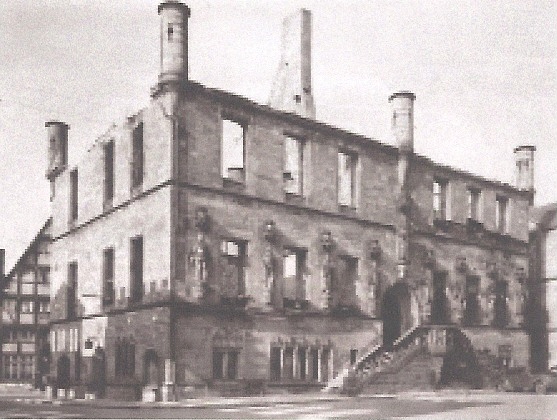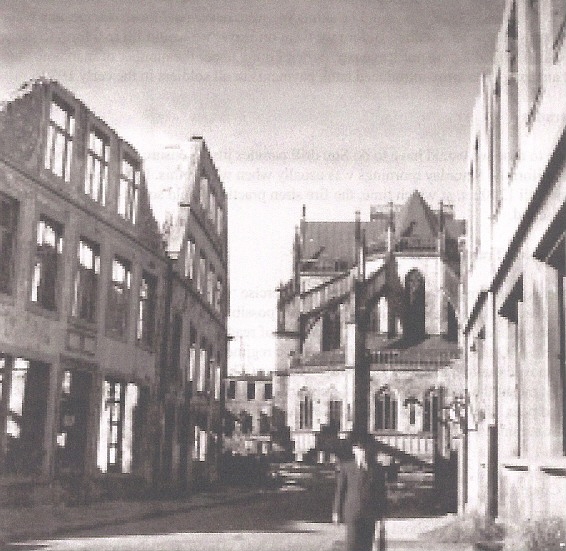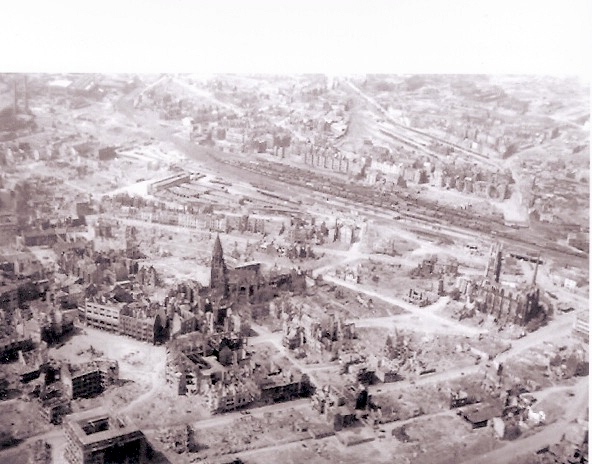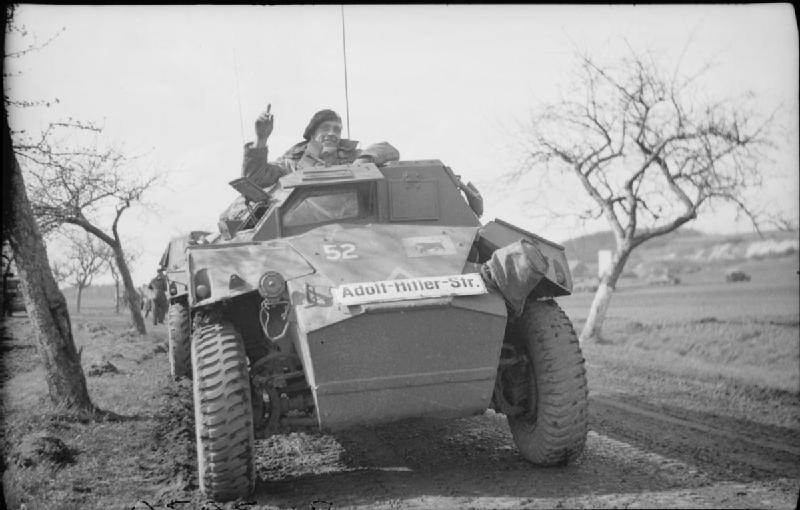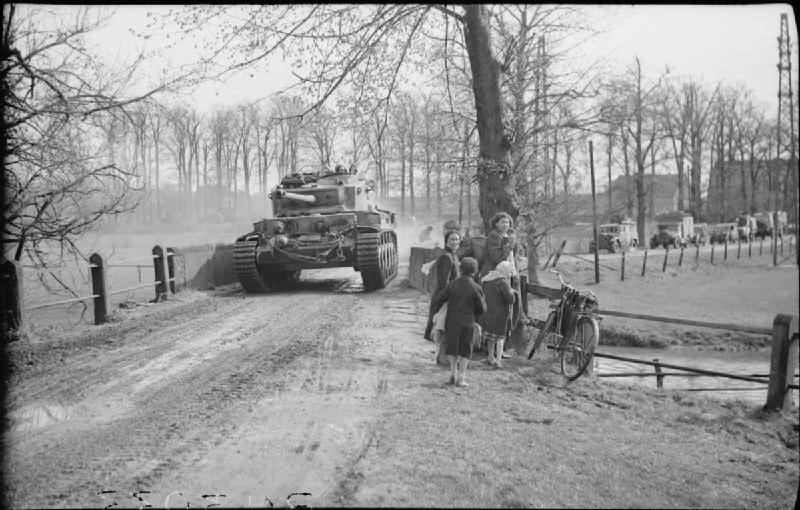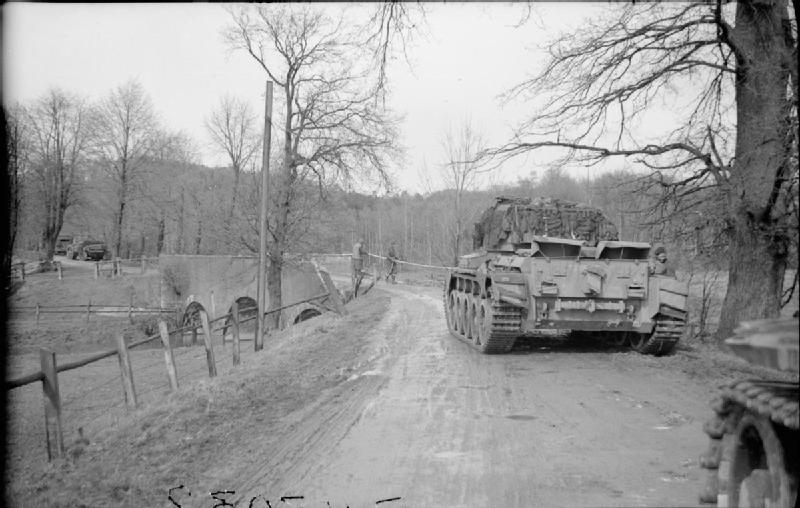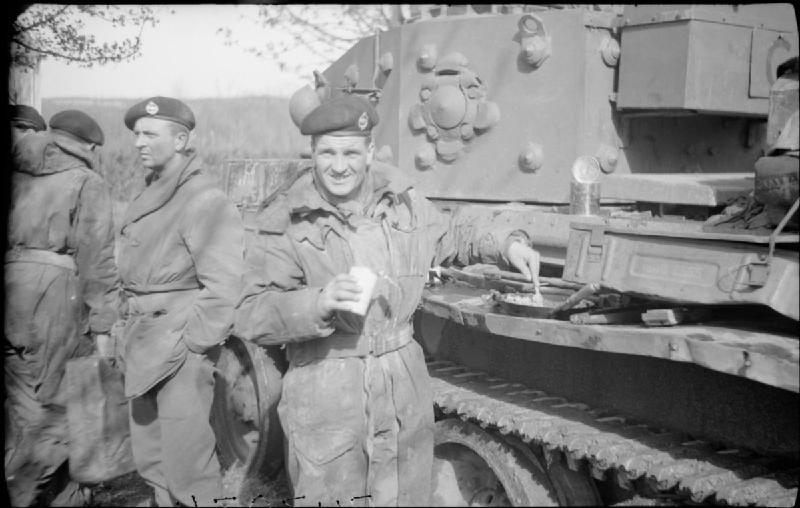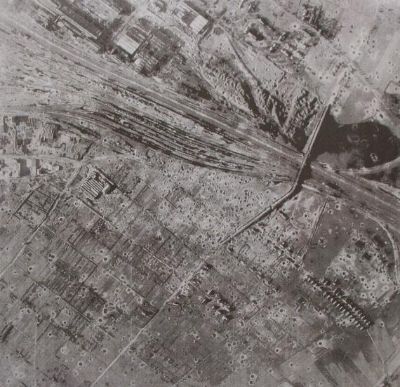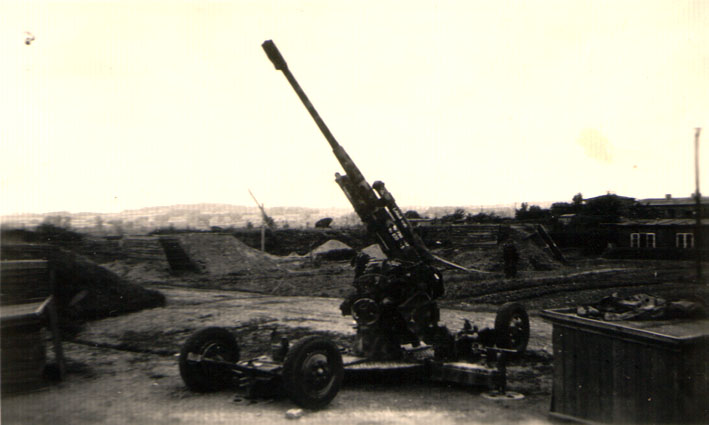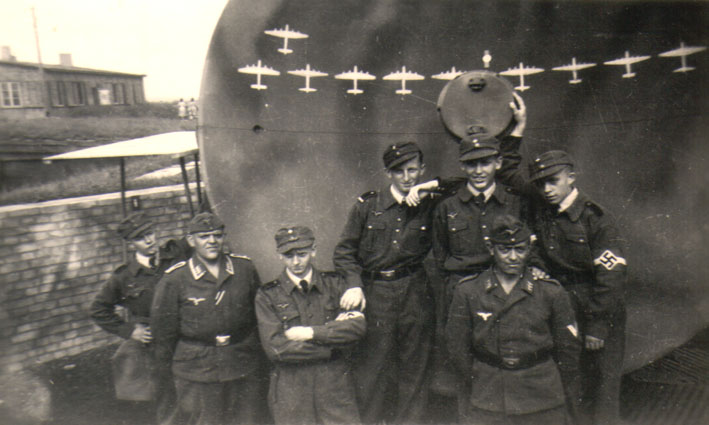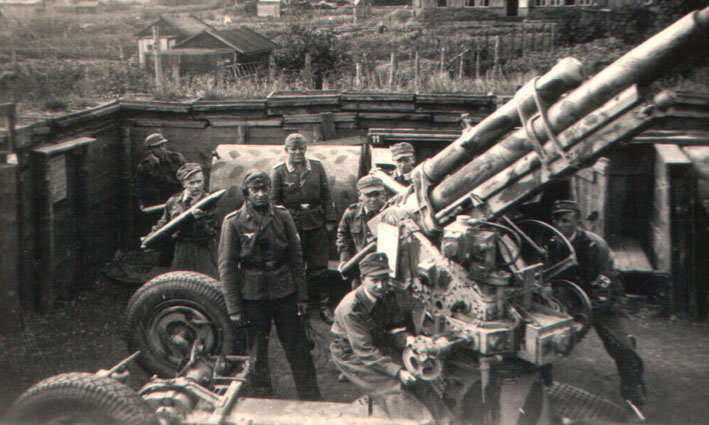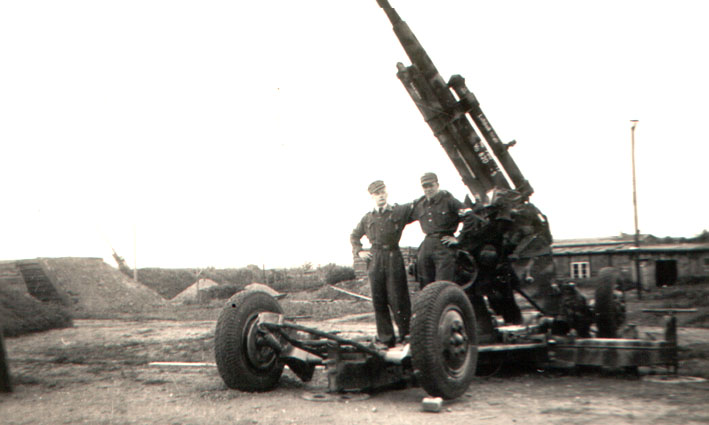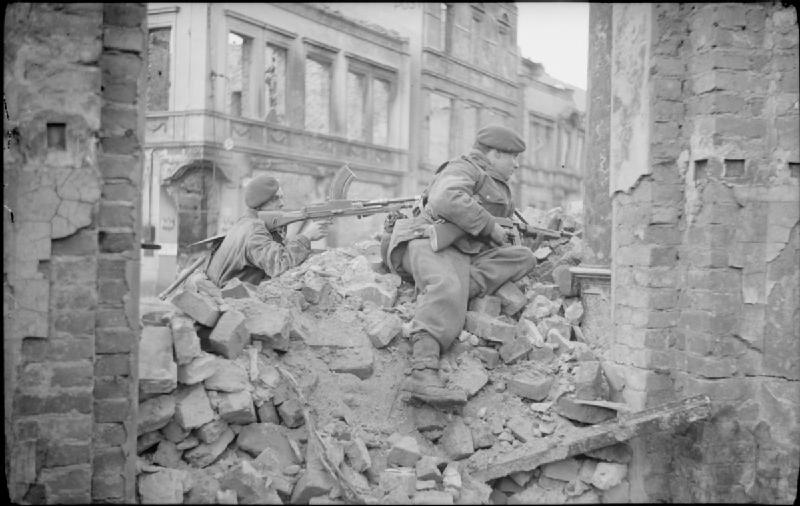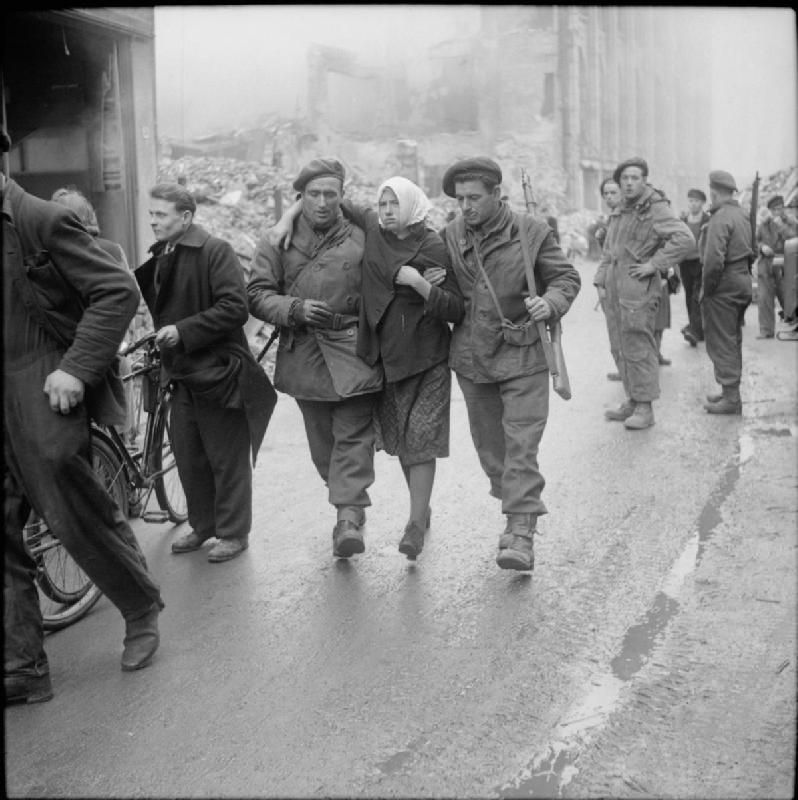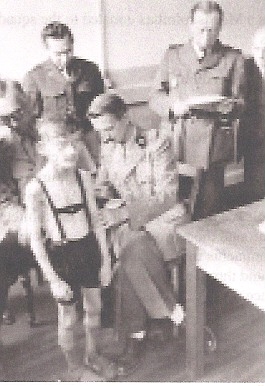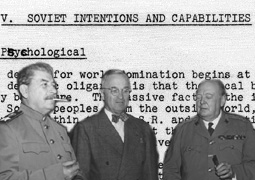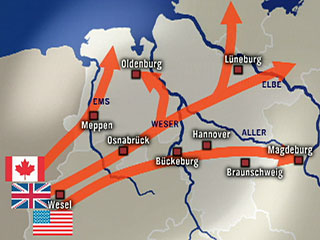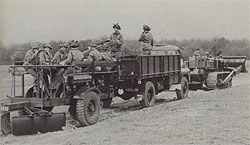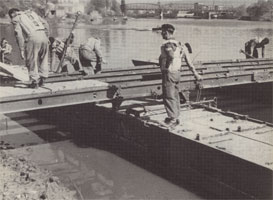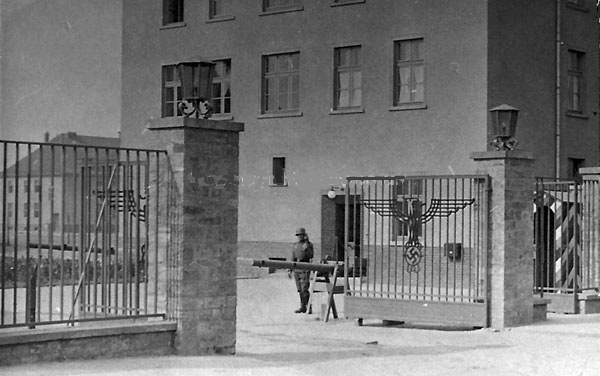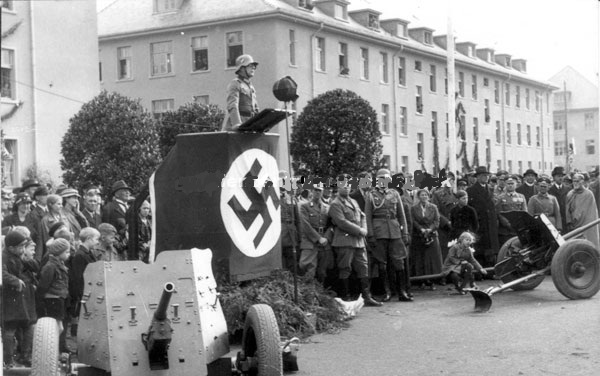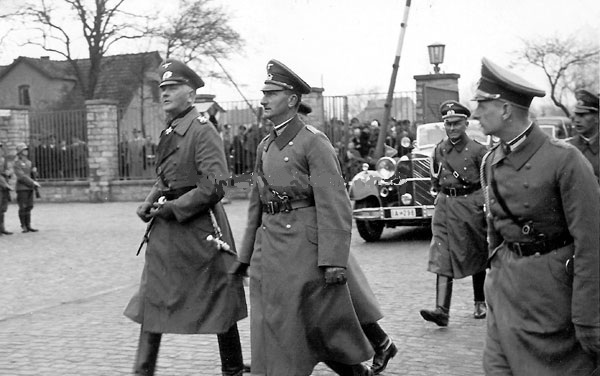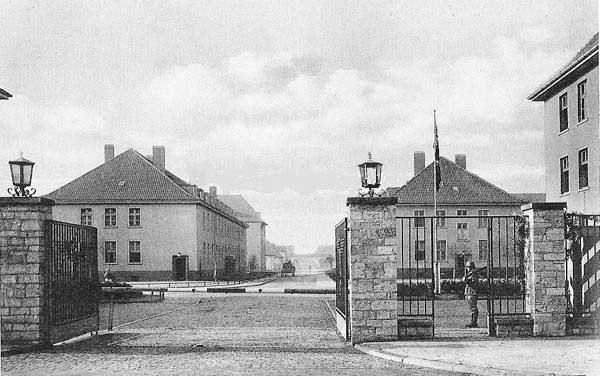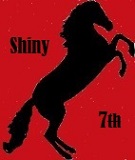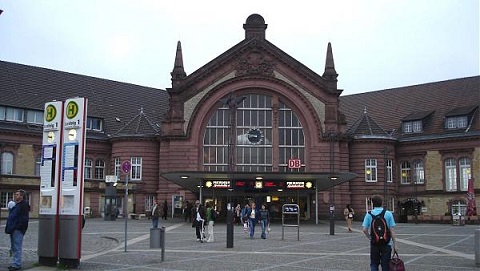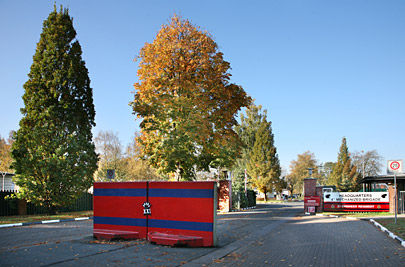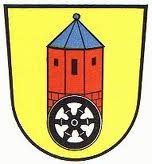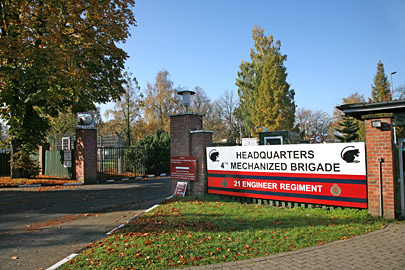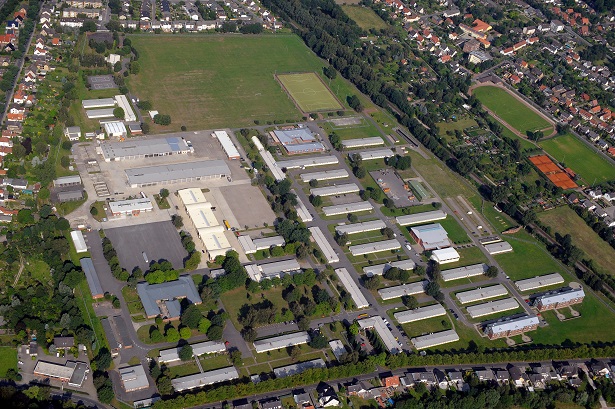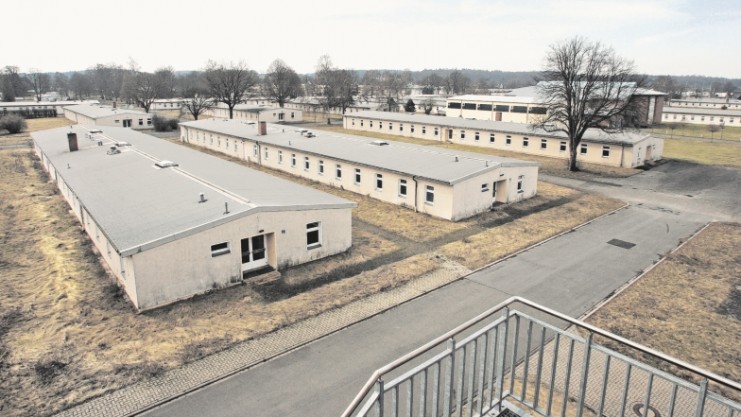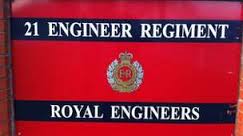Osnabruck
Osnabruck Coat of Arms
The Heger Tor
Osnabruck Theatre
Osnabrück is a city in Lower Saxony, Germany, some 80 km NNE of Dortmund, 45 km NE of Munster, and some 100 km due west of Hanover. It lies in a valley penned between the Wiehengebirge and the northern tip of the Teutoburg Forest, which is a series of parallel ridges running SE towards Bielefeld and beyond to Detmold, that makes the generally pretty area attractive to bicycle riders, amongst others. As of 30th June 2002, its population was 163,919, making it the third largest city in Lower Saxony.
History
Osnabrück was founded in 780 by Charlemagne, king of the Franks, although the date is not entirely certain. Some time before 803, the city became seat of the Bishopric of Osnabruck. This date is also uncertain, but it makes Osnabrück the oldest bishopric in Saxony. In 889 it was given merchant, customs, and coinage privileges by King Arnulf of Carinthia. It is first mentioned as a "city" in records in 1147. Shortly afterwards, in 1157, Emperor Frederick Barbarossa granted the city fortification privileges (Befestigungsrecht). Most of the towers that were part of the medieval fortification are still visible in the city. Osnabrück became a member of the Hanseatic League in the 12th Century, as well as a member of the Westphalian Federation of Cities.
Still a bishopric today, the city has a fair-sized cathedral in the late romanesque style. While nothing is left of the original cathedral from the city's foundation, excavations have traced the oldest parts of today's building to the 10th century. Most of it stems from the 12th and 13th centuries though, with the choir being a later gothic addition. Curiously, the southwestern tower that was also added later in gothic style occupies four times the ground space of the older, northwestern one. The plan to re-erect the second tower was never executed, making the two towers look very much out of proportion to each other.
Since the citizens elected to follow the course of the Protestant reformation, this led to an ongoing conflict with the Catholic bishop that was not resolved until the 17th century. Probably the most significant event in the city's history was then the negotiations from 1643 to 1648 that led to the Peace of Westphalia that ended the Thirty Years’ War. Since the Catholic and the Protestant delegations refused to negotiate in person, the Catholics were seated in Münster, while the Protestants resided in Osnabrück. The Friedenssaal, where the negotiations took place, can be seen in the city's impressive Town Hall building from 1517. For the city, the Westphalian Peace led to the unique regulation that it would be governed alternately by a Roman Catholic and a Protestant bishop, with the Protestant bishops being nominated by the Dukes (later Electors) of Brunswick-Luneberg. This led to the last prince-bishop, Prince Frederick, Duke of York and Albany (1763-1827), being elected at the age of 196 days to enable him to hold the position for as long as possible. Today, the city's population is roughly divided between the two confessions.
In the course of the secularization that preceded the dissolution of the Holy Roman Empire, the Bishopric of Osnabrück was appropriated into the Kingdom of Hanover in 1803. This was confirmed by the Congress of Vienna in 1815. Not until 1858 was the diocese re-erected as a church entity, while the city continued to belong to Hanover and thus also became part of Prussia with the annexation of Hanover in 1866.
Osnabrück suffered very much from the bombings at the end of World War II, but selected parts of the historic buildings have been re-erected. Today's Altstadt thus may not be entirely original, but still delivers the impression of a medieval city.
Osnabruck during the War
Like most German cities, Osnabrück was all but destroyed by Allied bombing in the Second World War. The flight paths of both the British and American bombers from London to Berlin and Central Germany were directly over Osnabrueck. Thus, on their return flights they casually dumped their left over bombs on the city. Osnabrück was among the first and the last bombed German cities. On September 4, 1939, sirens sounded in Osnabrück for the first time, the first of 2,400 trips to shelters and cellars for Osnabrückers during the course of the war.
On June 23, 1940, bombs fell on Osnabrück, 78 air raids later, and Osnabrück was no more. The last bombing took place on March 25, 1945. 181 aerial mines, nearly 25,000 high explosives bombs, over 650,000 incendiary bombs and nearly 12,000 liquid incendiary bombs were dumped between 1942 and 1945 over Osnabrück. The bombardment killed 2 thousand people, including 268 Allied prisoners of war and nearly 2000 were injured. 750 major and 3600 smaller fires incinerated the city.
The old part of town was 85% destroyed. 14,000 dwellings were destroyed, leaving 87,000 people without
shelter. All industrial and public plants such as post offices and public utilities were demolished, 141 public buildings, 7 churches, 13 schools and a hospital went up in flames. 900,000 cubic meters of rubble replaced the ancient landmarks. After the war Osnabrueck became a British garrison town.
Osnabruck Pre-WW2
The inauguration of Winklehausen Kaserne in October 1935
An Der Nette Heide in 1935
The previous occupants in Winklehausen Kaserne (Roberts Barracks)
These guys were likely to perish in Russia
Central Osnabruck 1945
The British Army's 11th Armoured Division advance on Osnabruck 1945
Comet tanks of 11th Armoured Division advance towards Osnabruck, 2 - 3 April 1945
The crew of a Cromwell Tank prepare a meal during the advance on Osnabruck
Fledder Osnabruck 1945
88mm Flak Cannons on Lime Hill Osnabruck
Flak Crews on Lime Hill (Kalk Hulg) Osnabruck 1944
The Town Hall 1945
The Markt Platz 1945
1946 The British introduced a food programme, including a milk allocation to help children get their nourishment.
In 1946 British military medical officers visit schools to give all school children medical check ups. Due to chronic food shortages and poor living conditions at this time, much of the population suffered from malnutrition and diseases including, TB and Rickets. Hospitals where struggling to cope with the high number of patients.
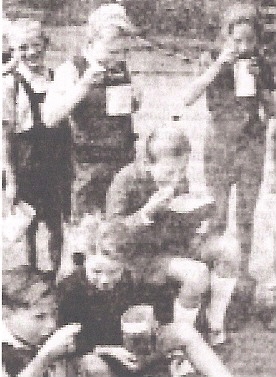
|
1945 |
Event |
|
04 April |
British 2nd Army occupy Osnabruck |
|
04 April |
The British appoint Dr Johannes Peterman as Headman, then later Burgermeister of Osnabruck |
|
05 April |
Winkelhausen Kaserne is used to accommodate displaced persons |
|
06 April |
The first shop in Osnabruck is reopened |
|
24 April |
The British distribute information leaflets to Osnabruckers |
|
08 May |
The Germany Army Surrender comes into effect. |
|
17 May |
Postal services resume |
|
26 May |
The main railway station is reopened for civilian traffic |
|
30 May |
Field marshal Montgomery takes residence at his HQ at Melle near Osnabruck |
|
14 Jun |
Field marshal Bernard Montgomery views his troops on parade in Cathedral Square, Osnabruck |
|
11 Jul |
The British administration allowed civilians to travel up to 100 kms in the British zone |
|
16 Jul |
Trams started to operate again in the streets |
|
17 Aug |
The 1st meeting by the British administration to appoint civilian councillors and the local council |
|
03 Sep |
Schools re-open in Osnabruck with 95 school classes |
|
15 Sep |
In accordance with decree No12, the British lay down the ground rules for the creation of political parties |
|
16 Sep |
British soldiers host a party for German children |
|
18 Sep |
A theatre union is created |
|
25 Sep |
Limited amounts of gas are restarted by the gas works |
|
25 Oct |
The British appoint Dr Petermann president of the town council |
|
10 Nov |
The Osnabruck CDU political party established |
|
30 Nov |
Dr Vollbrecht appointed Burgermeister |
|
13 Dec |
The British appoint Dr Vollbrecht town council director and Dr Adolf Kreft appointed Burgermeister |
|
24 Dec |
The curfew is lifted |
|
1946 |
|
|
15 Feb |
The sluice gates are repaired at Haste the Stich canal is back in operation |
|
07 Apr |
The Osnabruck SPD party formed |
|
28 Jul |
Dr Konrad Adenauer speaks in Osnabruck |
|
15 Sep |
First Borough elections since the end of the war |
|
17 Sep |
The Osnabruck ‘Neu Tageblatt’ starts up |
|
13 Oct |
First democratic town and county elections in the British zone |
|
05 Nov |
Alderman Heinrich Herlitzius appointed Oberburgermeister of Osnabruck |
|
09 Dec |
The British approve the Niedersachsen parliament |
|
14 Dec |
the Marien Hospital is overwhelmed with the arrival of displaced persons transport delivering many old, young, hungry and frost bitten people from Silesia. |
|
14 Dec |
A block building programme announced to build approximately 3000 new homes |
|
1947 |
|
|
01 Jan |
The British and US zones join up to form the Bizone |
|
08 Jan |
8th Jan Due to the severe shortage of coal, electric heating was prohibited |
|
25 Jan |
A sports field and gymnasium given to Osnabruckens by the British military |
|
17 Apr |
First fashion show held at the theatre |
|
20 Apr |
Niedersachsen elections held |
|
01 May |
Trade Union meeting in Cathedral Square |
|
02 May |
Repair work starts on the town hall |
|
13 Jun |
Bread is rationed to 500 grams per day |
|
26 Jul |
Hammersen spinning works working again |
|
10 Aug |
The Moscow swimming hall is back in use |
|
12 Aug |
The block building programme is cancelled due to lack of labour and materials |
|
12 Aug |
The Siemens-Martin-Hochofen steelworks back in use |
|
05 Oct |
Play begins in the newly formed football-Oberliga North |
|
27 Nov |
The dome on the cathedral is repaired |
|
12 Dec |
A large scale raid takes place against black-market traders in Augustenburger Platz |
|
13 Dec |
The Nue Tageblad reports that the Moscow foreign ministers conference, announces that all prisoners of war will be released by the end of 1948 |
|
1948 |
|
|
01 Mar |
The Lazarett St Angela in Haste, is no longer required as a hospital and returned to the Convent |
|
16 Mar |
The British suggest that Osnabruck should be twinned with a town in England |
|
10 Apr |
The British employ 6000 civilians throughout the British Garrison |
|
20/21 Jun |
The West German Deutsch Mark is introduced |
|
21 Jun |
In spite of the difficulties Osnabruck manages to build 2,560 new dwellings totalling 8,940 rooms |
|
21 Jun |
The town hall is reopened |
|
1949 |
|
|
23 May |
The Parliament council announce the new constitution for West Germany |
|
23 Aug |
First elections in the West German Parliament |
|
18 Oct |
A new high garden school in Haste is opened |
|
20 Oct |
The Osnabruck population reaches 103,144, and is again classed as a large town |
|
1950 |
|
|
13 Jan |
A new Ritz cinema is opened showing a colour film, ‘The Red Shoe’ |
|
20 Jan |
Fuel gas for vehicles is no longer restricted |
|
01 Jul |
A new children’s hospital is opened at Schoelerberg |
|
01 Jul |
The rebuilt city theatre is opened |
|
1951 |
|
|
27 Jan |
The war damage to the canal bridge at Romereschstrasse near Kammeren is repaired |
|
02 May |
West Germany is internationally recognised as a European nation |
|
01 Jul |
Building begins on a new savings bank, post office and police station in Rosen Platz |
|
1952 |
|
|
01 Jan |
Osnabruck 2,553 cars, 1,469 commercial vehicles and 1,653 motorcycles are registered in the town |
|
1955 |
|
|
11 Sep |
Negotiations take place between West Germany and the Soviet Union to release the remaining German prisoners of war |
|
18 Oct |
11 years of hard labour, as POW in the Soviet Union, 3 Osnabruck former soldiers return to Osnabruck to the sound of church bells ringing to celebrate their new freedom |
|
04 Nov |
New traffic plans set out for the internal infrastructure of Osnabruck |
|
10 Nov |
The town council announce repairs to be made to the historical market and to build new council offices |
|
17 Nov |
The council declares Fledder, an industrial area |
|
1957 |
|
|
Nov |
7 Field Squadron arrive in Osnabruck |
|
1960 |
|
|
|
The Osnabrücker trams are decommissioned |
|
1964 |
|
|
|
The pedestrian tunnel at the new market is opened |
|
1965 |
|
|
06 Mar |
George Cowie,Bob Blakey,Henry Aukinson,Ginge Lee,Sid Garrety,Stuart Clee and Ted Cox arrive in Osnabruck to join 7 Field Squadron RE |
|
1968 |
|
|
Jan |
7 Field Squadron depart Osnabruck for Ripon |
|
1996 |
7 HQ Squadron return to Osnabruck at Quebec Barracks |
|
2003 |
|
|
|
Osnabrück was voted the place with the happiest people in Germany by the Stern magazine, resulting in the slogan "Ich komm' zum Glück aus Osnabrück " (Luckily, I am from Osnabrück). |
|
2005 |
|
|
|
The City’s population 164,066 |
|
2008-2009 |
|
|
|
7 HQ Squadon and the remaining British troops pull out of Osnabruck and hand-over all the barracks they occupied to the local authorities |
|
18 Dec |
Roberts Barracks is formerly handed over to the local authorities |
|
Mar 2009 |
The last of the British Troops leave Osnabruck |
Main Diary of events Post War Osnabruck
Left and above: Osnabruck, Russian slave labourers are rescued from a cellar by the British Army after it was set alight by a German Policeman. April 7 1945
In March 1945 the Allies reached the Rhine River and on the 24th March the British 2nd and the Canadian 1st Army crossed the Rhine at Xantel, Rees and Wesel The meticulously planned crossing also involved Operation Varsity, the largest airborne parachute drop in history by XV111 US Airborne Corps, which included the British 6th Airborne Division and 1 CDN Para Bn. The drop was to take place when the ground forces crossed onto the east bank of the Rhine. Winston Churchill arrived to witness the drop. The crossing and the parachute drop all went to plan. (This parachute drop is used as an example at ‘West Point’ as to how a parachute drop should be) The objective of the British and Canadians soon got underway, the advance north east towards the Elbe, Hamburg, Lubeck and the Baltic, while American Units moved east and south to Bavaria after they captured the industrial Ruhr.
Enroute, Cities, Towns and villages had to be cleared of varying levels of resistance. 11 Armoured Division and The 159th Infantry Brigade, after capturing Mesum, Metelen, Rheine, Burgsteinfurt, Reisenbeck and Birgte were held up on the 31st March at the demolished bridges on the Dortmund Ems Canal with the formidable feature of the Teutoburger Wald in view. Fortunately the water level of the canal was much lower than usual due to the RAF’s previous bombings, and units eventually crossed onto the east side. Ahead lay the well defended Reisenbecker ridge in the dense Teutoburger Forest. On the 2nd April 1945 fierce resistance was encountered as the 3rd Monmouths and 1st Herefords entered Teutoburger Wald, the last obstacle on the approach to Ibbenburen. The Monmouths suffered heavy losses in the fighting, losing nearly all of their officers, so much so, they had to be replaced as a front line unit. A fanatical, dedicated force of German officer cadets and their instructors from the officer school in Hanover were making a desperate last stand. Close quarter combat and bayonet charges were encountered. It was during this campaign a rare truce took place. A young German officer who could speak English, accompanied by a British prisoner, and a white flag came up to the British and asked for a cease fire so that the dead and wounded from both sides could be collected and attended. The British agreed and the firing stopped for a while until this was done.
Many battle honours were awarded to officers and other ranks of the 1st Herefords and 3rd Monmouths from this particular campaign, including a VC. The VC was awarded to Corporal Ted Chapman of the 3rd Monmouths for showing great bravery, heroism and valour in battle.
The fighting continued until late on the 3rd April when reinforcements arrived from the Devonshire Regiment, a full brigade of infantry.
While this activity was going on the 15/19 Hussars armoured units had travelled east towards Brockterbeck and Techlenburg and took a second road winding its way through the forest which led to Ibbenburren. They reached the northern side of the forest and attacked there, however the attack had to be called off due to poor light and they returned to their start position at Brockterberg. The attack then turned to Tecklenburg, which also saw some heavy fighting. The Allied High Command decided that the 11th Armoured Division and the 159 Infantry Brigade, now with the Cheshires replacing the 3rd Monmouths, should leave this area immediately and proceeds on their original centre line of attack towards Osnabruck and Hanover. It was then left to 7th Armoured Division to capture Ibbenburen having first dealt with the depleted resistance. This was the task for 4th KOSB and its supporting armour. On the 4th April fierce fighting was again encountered on the ridge and there were also casualties from ‘Friendly Fire’ from armoured units arriving in support. Key bridges in Ibbenburren were taken when the Germans retreated to Furstenau where they were later captured. Teutoburger Wald and Ibbenburren were finally captured on the 7th / 8th April 1945.
While the fighting was ongoing in the Teutoburger Wald, Osnabruck was captured by the British and Canadians of 8th Corps on the 4th April 1945. Having crossed the Dortmund Ems canal relatively easy, Osnabruck was soon cleared. Heavy resistance was met on the outskirts of Minden. The bridges had been blown, however when 6th Airborne Division entered in the evening the town was empty, consequently Minden fell on the 5th April 1945. Minden was actually an objective of the US 9th Army who arrived soon afterwards. They had captured Munster on 3rd April and they took Hameln on 7th April 1945. On the 8th April the Canadians took Wunsdorf. Bergen -Belsen was liberated by 11th armoured Division on 15th April 1945. By this time the British 2nd Army was moving swiftly towards the Baltic and although they met some heavy resistance in places it was soon repelled. Towards the end of April the Germans were surrendering more readily as they were aware the Russians were advancing in the east and they didn’t want to fall into their hands. Some German soldiers were actually surrendering with their wives and children, as they were terrified at being taken prisoner by the Russians.
The British 6th Airborne Division reached Wismar on the Baltic and then halted, as they had reached the agreed meeting line with the Soviet forces, who arrived later. The British raced to Wismar ahead of the Soviets as they feared they intended to advance to the Danish Peninsular and Copenhagen.
The war came to an end on 7 May 1945, and British forces reoriented to the task of occupying Germany itself.
The closing stages of the war in Germany Operation Plunder and Varsity 1945
Closing stages of the war Centre lines off attack
On the 7th May 1945 Germany surrendered unconditionally and ceased to be a state.
The allies had previously agreed on partitioning Germany into 3 zones of occupation. Soviet, British and American. Each zone was administered by their respective military administration. Austria was separated again from Germany, as was the Saarland that was to be placed under French administration. A 4th zone of occupation was located in Berlin and split in 4 sectors, British, American, French and Soviet. The Germans refer to May 8th 1945 as ‘hour zero‘, in which life for them started again. The 12 years of Nazi rule and terror was ended. Now the most serious problem was how to survive the next few weeks. People had money but there was precious little to buy and what was for sale didn’t come cheap. People travelled around the farms trying to trade their valuables for food. To survive, many had to steal coal from the railways and anywhere else it could be found. Most cities were destroyed as much as 70% as the result of allied bombings, leaving many people homeless. This was acerbated by millions of refugees moving back to Germany from the annexed East Prussia, Poland, Hungry and the Sudeten Germans of Czechoslovakia. After 6 years of war the population consisted of mainly children, women and the elderly. Adult men were in short supply and of these many were invalided. The task of removing the rubble from the streets fell to the women who reclaimed whole bricks to rebuild. These women were known as Trummer frauen. (Rubble women) The winters of 1945/46 and 1946/47 were very cold, many homes were still damaged, and there were still shortages of coal. Many people were undernourished and starved or froze to death. The British and the Americans in their respective zones did their best to alleviate the situation. British efforts to prevent the German population from starving put great strain on the country’s economy, which was still trying to recover from 6 years of war.
In 1946 region states were established in all 4 zones of occupation, democratically elected, with limited authority. The military administration still was in control. Germans who wanted to take political office, to work as public servants, teachers, policemen, judges etc, needed papers documenting that they had not been Nazis. The occupying forces increasingly influenced the direction political life was taking. In the west, the re-establishment of democratic parties was encouraged. The CDU as a party representing Christian politicians. The FDP as the liberal party. The KPD were communists, they were tolerated but the military administration preferred not to see them in governing positions. It became obvious that western and eastern zones of occupation were developing in different directions. By 1947 the British were unable to maintain supplying food and fuel to the Germans in their sector and turned to the Americans for help. This situation together with the growing prominence of communism prompted the Americans to adopt a new policy for Germany in that it should be made into a state so that it could sustain itself, and vitalise a new German economy. The British and the American zones were united to form a Bizone. Later the French joint their zone to form a trizone. In 1948 the Allies tacitly permitted the German Central Bank to proceed with a currency reform, establishing the D-Mark as the country’s new, hard currency. Everybody was given a start sum of 40 DM. The black market collapsed immediately and the shops started to fill with goods. The Soviets were furious about the currency reform put in place without informing them. Germany was now divided in 4 regions- the US, British and French zones of occupation (West Germany) and the Soviet zone (East Germany). West Berlin (the western sectors) and East Berlin (the Eastern sector
Post war Germany the creation of BAOR & formation of RE Units.
Advance on Osnabruck 2-3 Apr 1945
Commandos of 1st Special Service Brigade
in Osnabruck, 4 April 1945.
April 4th, 1945: The British Second Army captures Osnabrück
The war ended in Osnabrück on April 4, 1945, when the XV11 Corps of Montgomery’s Second Army entered the city with little resistance. Leading Nazis fled the city and the British appointed a new mayor, Johannes Petermann. However, power rested chiefly with the occupiers, represented locally by the military governor, Colonel Geoffrey Day. Relations between the occupiers and the people of Osnabrück were generally peaceful, though tensions existed; some small fights broke out between British soldiers and local youths and some Osnabrückers resented the relationships that developed between the occupiers and local women. Additionally, the British took over more than seventy homes for their own use by the middle of 1946. Amidst shortages, the black market thrived and became a main focus of police activity.
A short excerpt from an inhabitant of Osnabruck during WW2
I am half German, my Grandfather was a dentist in Osnabruck and my mother told me how the city was hit many times. Her own house was hit 3 times and everyone survived and continued to live in the ruins but, after the last heavy raid the house fell on the fourth time.
My mother told me how after being rescued from the cellars "you could see all across the city as nothing was left". My mother & grandmother fled as refugees & lived in ditches to hide from "fighter planes who shoot at us" she told me.
My grandfather continued a dental practise in the 'strasa' and help clear the rubble until the city was liberated from Nazi oppression by the allies.
Creation of the British Army of the Rhine (BAOR) - 1945 www.re-museum.co.uk
British Army on the Rhine was formed on 25 August 1945 from 21 Army Group. Its original function was to control the corps districts which were running the military government of the British zone of occupied Germany. After the assumption of government by civilians in 1948, it became the command formation for the British troops in Germany.
As the Cold War intensified, BAOR became more responsible for the defence of West Germany than its occupation. After the formation of the alliance known as North Atlantic Treaty Organisation (NATO) in 1949, BAOR became the primary formation controlling the British contribution to NATO. Its primary combat formation was 1 (BR) Corps. From 1952, in the event of a general war with the Soviet Union and the Warsaw Pact (formed in 1955), the commander-in-chief of the BAOR also acted as the commander of NATO's Northern Army Group (NORTHAG) .
The Royal Engineers in post-war German rehabilitation 1945-50
Immediately after the surrender of Nazi Germany, in the British zone, the Royal Engineers were tasked with the supervision of 'getting Germany back on its feet'. They supervised the reinstatement of public utilities (water and electricity) and the reconstruction of roads, bridges and railways, in many cases using German Army engineer and transportation units. German municipal engineers took on the maintenance of many of the Bailey bridges that had survived the war and began to replace them by permanent structures.
Because there was an urgent need for mapping and survey data to administer the British zone, Royal Engineer surveyors were called upon to assist in the rehabilitation of the German mapping, however by 1948 the German civilian survey and mapping was working essentially under their own management.
Royal Engineer Transportation units were employed re-establishing German railways and ports, and in some cases actually operating them.
Early organisation of the Field Engineers - 1945-52
After the war the Army strength in Germany was rundown as follows:
December 1945 - Three corps of thirteen divisions.
1947 - Three divisions.
January 1948 - one division (2 Infantry Division).
Such a reduction had obvious consequences on the field units of the Royal Engineers, the squadrons in those divisions which disbanded were mostly placed into suspended animation and their manpower absorbed elsewhere. Some of the units that survived were:
2 Infantry Division RE - became 23 Field Engineer Regiment.
7 Armoured Division RE - formed 1 Engineer Training Establishment, Hameln.
5 Infantry Division RE - reorganised as 23 Field Engineer Regiment
30 Army Troops Engineers returned to the UK in 1947.
32 Assault Engineer Regiment returned to the UK in 1948
29 Army Troops Engineers returned to the UK in 1948
After the Berlin Blockade (1948) it was apparent that the Soviets posed a threat and in June 1949 the British started to rebuild the strength of BAOR as follows:
June 1949 - 7 Armoured Division reformed (its first commander was the engineer General Sir Charles 'Splosh' Jones) - 21 Field Engineer Regiment was raised in Holzminden as the Division's engineers, the manpower came from 1 Engineer Training Establishment which was closed.
Autumn 1950 - 11 Armoured Division reformed - 26 Field Engineer Regiment was formed in Hameln as the Division's engineers. To make room at Hameln 21 Field Engineer Regiment moved to Neinburg.
April 1951 - 11 Engineer Group was formed to provide engineer support at Corps level.
1 (British) Corps (1 (BR) Corps) was formed in the summer of 1951 by combining the three divisions (2 Infantry, 7 and 11 Armoured Divisions).
Organisation of Field Engineer Units in 1952
CCRE 1 (BR) Corps (Commander Corps Royal Engineers 1 British Corps)
|
2 Armd Div |
6 Armd Div |
7 Armd Div |
11 Armd Div |
11 Engr Gp |
Canadian Bde Gp |
23 Fd Engr Regt
Dortmund
2 Fd Sqn
5 Fd Sqn
38 Fd Sqn
21 Fd Pk Sqn |
27 Fd Engr Regt
Minden
1 Fd Sqn
25 Fd Sqn
28 Fd Sqn
44 Fd Pk Sqn
|
21 Fd Engr Regt
Nienberg
4 Fd Sqn
27 Fd Sqn
48 Fd Sqn
45 Fd Pk Sqn |
26 Fd Engr Regt
Hameln
7 Fd Sqn
29 Fd Sqn
60 Fd Sqn
43 Fd Pk Sqn |
37 Army Engr Regt
Osnabruck
33 Fd Sqn
34 Fd Sqn
35 Fd Sqn
41 Fd Pk Sqn |
58 Ind Fd Sqn RCE
Hameln |
38 Corps Engr Regt
(Osnabruck)
61 Fd Sqn
62 Fd Sqn
63 Fd Sqn
27 Pl Trg Sqn
|
|
|
|
|
|
In Autumn 1951 a Canadian Brigade Group arrived in Germany to strengthen NATO forces. Its engineers, 58 Independent Field Squadron, RCE was accommodated with 26 Field Engineer Regiment RE at Hameln, but later moved to the Canadian Brigade Group area around Werl and Soest.
Training with Class 9 Folding Boat Equipment Raft Hameln 1953
Laying Mk 7 Anti Tank Mines-early 1960s
Organisation of Field Engineer Units in 1960s CCRE 1 (BR) Corps (Bielefeld)
CRE 1Div
Verden |
CRE 2Div
Lubbecke |
CRE 4Div
Herford |
Comd 11 Engr GP
Osnabruck |
4 Fd Sqn
Fallingbostel
7 Fd Sqn
Osnabruck
45 Fd Pk Sqn
Nienberg
|
5 Fd Sqn
Paderborn
2 Fd Sqn
Munster
43 Fd Pk Sqn |
29 Fd Sqn
Hameln
1 Fd Sqn
Sennelager
44 Fd Pk Sqn |
25 Corps Engr Regt
Osnabruck
37 Fd Sqn
39 Fd Sqn
35 Corps Engr Regt
16 Fd Sqn
30 Fd Sqn
42 Fd Sqn
65 Corps Fd Pk Sqn
|
26 Amd Engr Sqn
Hohne
By 1960 each brigade within the divisions had its own field squadrons and each division had its own field park squadron. Additional support was provided by the Army and Corps engineer regiments within the 11 Engineer Group.
National Service enabled the BAOR field squadrons to have two officers per troop, however by 1962 the last of the National Service soldiers had left and as a consequence the field squadrons were reorganised to accommodate the change. Each troop had just one officer, but the troop sergeant was upgraded to staff sergeant and an extra sergeant was added.
In 1961 the brigade field squadrons reverted to divisional CRE command though many remained dispersed in their brigade areas. They were gathered together as engineer regiments in 1965, the Divisional CREs being the commanding officers of the regiment.
The Light Wheeled Tractor (LWT) was issued to field squadrons in 1961, which helped to speed up many of the engineering tasks in the field.
As the 1960's progressed it was evident that the Warsaw Pact was amassing tanks, which NATO forces countered with their move towards mobility and armoured vehicles. In the late 1960's the field squadrons were equipped with the FV 432 (a tracked armoured personnel carrier (APC)). The vehicle provided greater mobility, as well as, a power source for driving a whole range of electrical tools. It was also adapted as a tractor for pulling the new bar-minelayer.
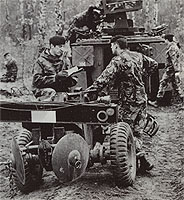
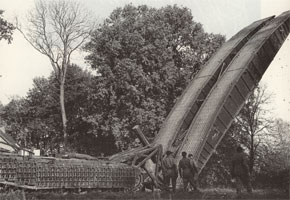
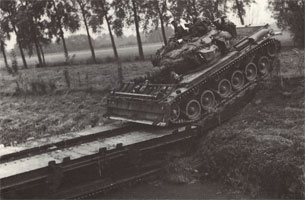
Bar Mine Layer pulled by FV432 APC in the 1970's
Centurion AVRE crossing an ARK on exercise in Germany
Centurion Bridgelayer laying MK 6 Tank Bridge
Armoured Engineers
The armoured engineers had their origins in the assault engineers of the Second World War (1939-45 whose units, at the end of the war, were either disbanded or returned to Britain.
In September 1957, 26 Armoured Engineer Squadron RE, equipped with Churchill Armoured Vehicles RE (AVRE) Arks, Flails, Bridgelayers and No 3 Tank Bridges moved back to BAOR. In 1963 the Squadron was equipped with No 5 Tank Bridge.
Armoured engineer capability was enhanced in 1965 when 2 Field Squadron RE was converted to form 2 Armoured Engineer Squadron RE. In the same year 32 Armoured Engineer Regiment was reformed with 2 and 26 Armoured Engineer Squadrons.
Organisation of Field Engr Units in 1970 CCRE 1 (BR) Corps (Bielefeld)
CRE 1 Div
Verden |
CRE 2 Div
Lubbeke |
CRE 4 Div
Herford |
Corps Tps Engrs |
21 Engr Regt
Nienberg
1 Fd Sqn
4 Fd Sqn
32 Engr Regt
Hohne
30 Fd Sqn
37 Fd Sqn
26 Armd Engr Sqn
Hohne
45 Fd Pk Sqn
Nienberg |
23 Engr Regt
Osnabruck
7 Fd Sqn
Ripon
16 Fd Sqn
Osnabruck
25 Engr Regt
Osnabruck
16 Fd Sqn
31 Armd Engr Sqn
Osnabruck
43 Fd Pk Sqn
Osnabruck
|
26 Engr Regt
Sennelager
5 Fd Sqn
25 Fd Sqn
35 Engr Regt
Hameln
29 Fd Sqn
42 Fd Sqn
2 Armd Engr Sqn
44 Fd Sp Sqn |
23 Amp Sqn
Hameln
65 Corps Sp Sqn
Hameln |
Through the late 1950s and early 1960s bridge and ferry development had to keep pace with the rapidly increasing loads, particularly tanks that came into service to meet the Warsaw Pact threat. At the same time construction time had to be reduced to match increasing battlefield mobility. A solution was amphibious bridging, which had been was first muted during the Second World War (1939-45), but was not pursued in the 1960s the idea was resuscitated.
Amphibious Engineers
In May 1962 1 Troop, 50 Field Squadron RE was reformed as 23 Amphibious River Crossing Cadre, equipped with seven French EWK-Gillois amphibious bridges for trials. The trials proved encouraging and the Cadre was expanded into 23 Amphibious Engineer Squadron RE in 1963.
However, in June 1962 information came to light that convinced Staff that the German M2 Amphibious Bridging and Ferry Equipment was more suited to British requirements. By 1964 23 Amphibious Engineer Squadron RE was training with M2 rigs borrowed from the Bundeswehr (West German Army).
In early 1970 sufficient modified M2B rigs were available for 23 Amphibious Engineer Squadron RE to be divided into three troops each holding eight rigs. In April 1971 28 Amphibious Engineer Regiment was formed with 23 Amphibious Engineers Squadron RE and two new squadrons - 64 and 73 Amphibious Engineer Squadron RE.
Harrier Support -
By the end of 1970 the RAF had two Harrier Squadrons in West Germany, this threw up the requirement from the Royal Engineers to provide engineer support to the RAF Harrier squadrons operating from forward tactical sites. In 1973 10 Field Squadron RE was established at RAF Laarbruch to provide that support, it came under the command of the Chief Engineer BAOR.
The Cessation of BAOR
The 1993 'Options for Change' defence cuts resulted in BAOR being replaced by the 25,000 strong British Forces Germany (BFG) in 1994.
Main Equipment Developments 1950-1980
In 1953 the Royal Engineers Advisory Board was reconstituted by the Army Council as the Engineer Advisory Committee with special responsibilities for advice on research and development in the field of military engineering.
Development of engineering equipment at the Military Engineering Experimental Establishment (MEXE), Christchurch, Dorset, was greatly influenced by the needs of the field engineers supporting the armoured divisions in BAOR. A list of some of the main pieces of equipment are given below with their service introduction dates:
1952 - Extra Widened Bailey Bridge (EWBB).
1955 - Heavy Girder Bridge (HGB).
1955 - Twynham Hut.
1957 - Heavy Ferry.
1958 - Light Assault Floating Bridge (LAFB).
1962 - Gillios amphibian purchased.
1963 - Centurion AVRE and Bridgelayer.
1965 - Centurion Armoured Ramp Carrier (ARK).
1968 - Class 16 Air Portable Bridge.
1969 - Eager Beaver rough terrain fork lift truck and M2B amphibian.
1972 - Barmine and Layer.
1974 - Chieftain Armoured Vehicle Launching Bridge (AVLB).
1976 - Aids to amphibians.
1977 - Light Mobile Digger.
1978 - Combat Engineer Tractor.
1979 - Combat Support Boat.
Field Training
First Exercise - 1949 - The first real BAOR field training (exercise or manoeuvres) took place in 1949. The exercise was designed to train for the halting and repelling of a invasion by Soviet forces, a scenario that was to be acted out, until the end of the Cold War in 1991, by successive generations of soldiers in BAOR. For field engineers this generally meant deploying before their parent formation to prepare the obstacle plan, which included laying minefields, preparing demolitions and other works to enable their formation to move and fight in their allocated areas.
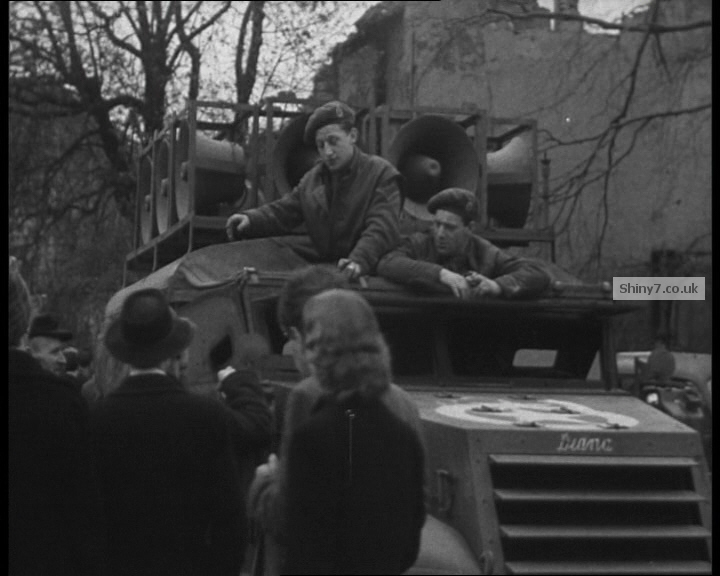
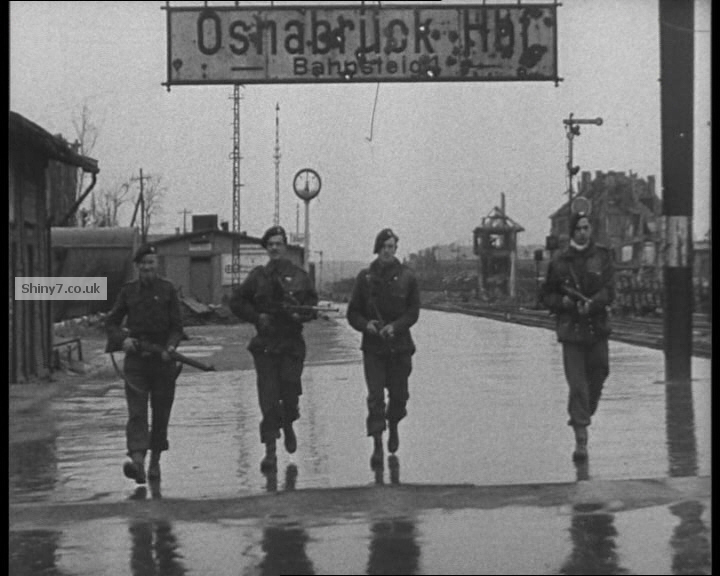
Post War Osnabruck
The Guard Room Winklehausen kaserne 1935/36
Main Gates to Winklehausen Kaserne 1936
Generalfeldmarschall Werner von Blomberg Reichs Defence Minister visits Winklehausen Kaserne 1936
Schinkleberg Osnabruck
The Shiny 7 has served twice in Osnabruck; November 1957 (Roberts Barracks) until January 1968 - Cold War period
1996 (Quebec Barracks) until August 2008 - Post Cold War
Osnabruck was a large garrison city, with barracks sprawled across the area accommodating many different regiments and Corps. There were always units coming and going, you would often bump into soldiers from different regiments in the shops, stores and bars when you were out shopping and socialising. Every soldier stationed in Osnabruck would have been many times to the army's main training ground at Achmer, a former WW2 airfield near Bramsche.
Those who served in Osnabruck will be most interested in the content of this page.
The Shiny in Osnabruck
Pre and Post War History
Osnabruck Main Railway Station
Invasion of Osnabruck
7 HQ SQN RE -1996 - April 2006
7 HQ & SP SQN RE - April 2006 - August 2008
Quebec Barracks
Lager Eversburg
7 Sqn Quebec Barracks - Post Cold War
Christmas in Roberts Barracks 1943
Weihnachten in der Winklehausen Kaserne 1943
Above: The orignal photo after colouring


